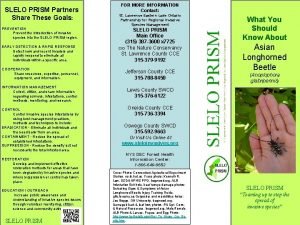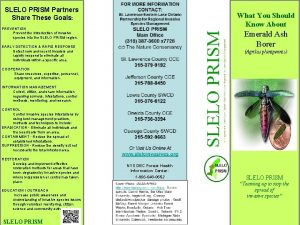SLELO PRISM Partners Share These Goals PREVENTION Prevent


- Slides: 2

SLELO PRISM Partners Share These Goals: PREVENTION Prevent the introduction of invasive species into the SLELO PRISM region. EARLY DETECTION & RAPID RESPONSE Detect new and recent invaders and rapidly respond to eliminate all individuals within a specific area. COOPERATION Share resources, expertise, personnel, equipment, and information. INFORMATION MANAGEMENT Collect, utilize, and share information regarding surveys, infestations, control methods, monitoring, and research. CONTROL Control invasive species infestations by using best management practices, methods and techniques to include: ERADICATION - Eliminate all individuals and the seed bank from an area. CONTAINMENT - Reduce the spread of established infestations. SUPPRESSION - Reduce the density but not necessarily the total infested area. RESTORATION Develop and implement effective restoration methods for areas that have been degraded by invasive species and where suppression or control has taken place. EDUCATION / OUTREACH Increase public awareness and understanding of invasive species issues through volunteer monitoring, citizen science and community outreach. SLELO PRISM FOR MORE INFORMATION Contact: St. Lawrence Eastern Lake Ontario Partnership for Regional Invasive Species Management SLELO PRISM Main Office (315) 387 -3600 x 7725 C/O The Nature Conservancy St. Lawrence County CCE 315 -379 -9192 Jefferson County CCE 315 -788 -8450 What You Should Know About Asian Longhorned Beetle (Anoplophora glabripennis) Lewis County SWCD 315 -376 -6122 Oneida County CCE 315 -736 -3394 Oswego County SWCD 315 -592 -9663 Or Visit Us Online At www. sleloinvasives. org NYS DEC Forest Health Information Center: 1 -866 -640 -0652 Cover Photo: Connecticut Agricultural Experiment Station, na. fs. fed. us. Frass photo: Kenneth R. Law, USDA APHIS PPQ, bugwood. org. ALB Infestation Exit hole, keaf tussye damage photos: Detecting Signs & Symptoms of Asian Longhorned Beetle Injury Training Guide, glfc. forestry. ca. Ovipositer and manidibles holes: Joe Boggs, OH University, bugwood. org. Damaged bark & leaf loss photos : PA Dpt. Cons. & Natural Resources, bugwood. org. Male/Female ALB Photo & Larvae, Pupae, and Egg Photo: http: //www. bethelalb. com/Get_To_Know_Our_Be etle. htm. SLELO PRISM “Teaming up to stop the spread of invasive species”

What is an Asian Longhorned Beetle The Asian longhorned beetle(ALB) (Anoplophora glabripennis), is a wood-boring insect native to China and Korea. ALB larvae bore through the woody tissue of many species of hardwood. This disrupts the flow of nutrients and water through the tree. Eventually, the tree weakens and dies from the infestation. Because the ALB targets several species of hardwood, the impacts of its infestation could be severe. More ALB Infestation Signs ALB Identification ØPresence of feeding galleries and tunnel entrances under bark ALB Adults: • Size: 1 -2 and a half inches in length depending on gender • Color: Black with distinctive white or light yellow spots on body and antennae *Antennae are longer on males than females Signs of an ALB Infestation ØPresence of severed leaf tissue and stripped tissue on twigs and petioles ØPresence of frass (wood shavings) ALB Larvae: • Size: Grow up to 2 ½ inches long • Color: Off white (Cream) ALB Pupae: • Size: About one and a half to two ) inches long • Color: Creamy white ØRound exit holes (6 -14 mm in diameter) ØPresence of holes from insect mouth parts (mandibles) and ovipositer (egg insertion) ØPresence of Cracks and or missing bark; dead branches discoloration & loss of leaves ALB Egg: • Size: Roughly the size of a grain of rice • Color: Milky white and flat turning yellow as it matures



